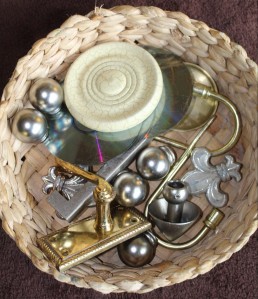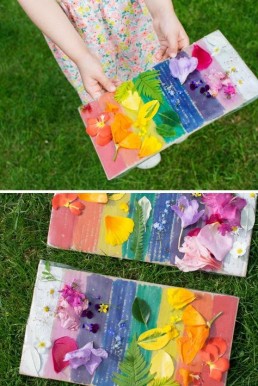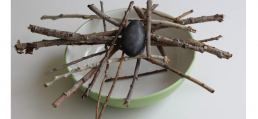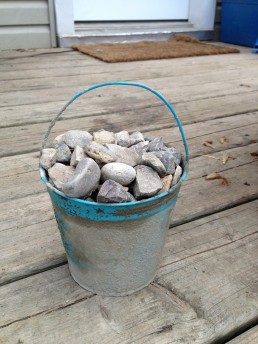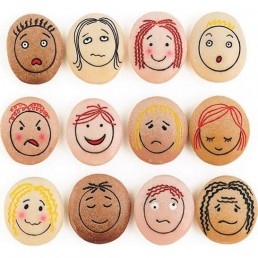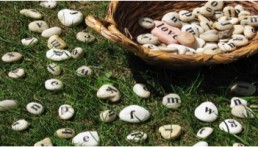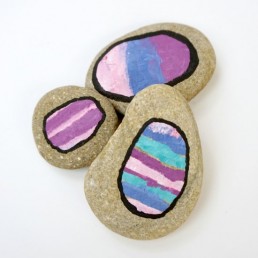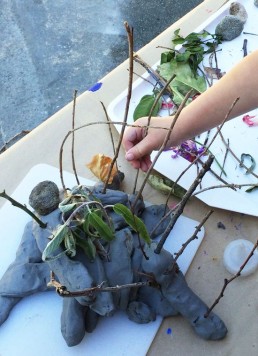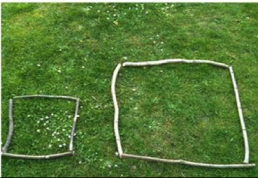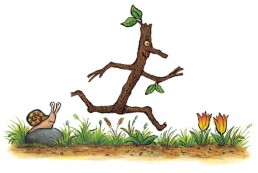Loose Parts
Why do we use loose parts?
Loose parts are a significant segment of our ethos at Inspirations Nurseries. Before moving away from conventional toys, we did a lot of research into the benefits of using loose parts. Several education pedagogies use loose parts. Reggio Emilia and loose parts complement each other well; we use both at Inspirations. Both philosophies support open ended play using natural resources, imagination, and creativity. When children are given opportunities to engage in free play with little adult direction, they are able to explore freely with creativity and expression, because there are no limitations or expectations.

What are Loose Parts?
Loose parts are open ended materials that can be moved around, designed, and redesigned. They create opportunities to use our imaginations and discover new ideas. Conventional toys are fixed for the one purpose they were made for, whereas loose parts are open ended and can be used for a variety of things. A plastic car can only be a car. A stick could be a magic wand or a person or you could use a number of them to make a house… the possibilities are endless. Ask any parent how long their children will play with the cardboard box a toy comes in on their birthdays. Loose parts can be found anywhere. How many of us remember going to the beach and collecting shells and stones and making patterns with them? You can find loose parts in the house, in the garden or on a walk. Loose parts include both manufactured and natural resources. These can include stones, pinecones, rings, balls, blocks, boxes, leaves and even nuts and bolts.


Endless Possibilities
For outdoor play, we provide a variety of large loose parts such as tyres of different sizes, milk crates, planks of wood, cable reels etc. In our baby rooms, we use a variety of loose parts to support schemas; we use things like curtain rings to hang on mug trees, balls to post through holes, tyres to encourage rolling. Toddlers can then use slightly smaller loose parts such as pebbles to create patterns and smaller wood slices for counting. Preschool are able to use more intricate loose parts such as beads, small tiles and items they find on forest school.
The founder of the Reggio Emilia Philosophy said...
“Children need the freedom to appreciate the infinite resources of their hands, their eyes and their ears, the resources of forms, materials, sounds and colours”.
-Kayleigh
See loose parts in action in our Pre-School room here- https://youtu.be/Nngfh6Uj-yw
All photos from Inspirations Nursery
Spring Colour Hunt
Resources: Pens or paints, paper/card, glue and natural loose parts

Implementation
Paint some colours or a rainbow onto paper, see how many natural items you can find outdoors to match the colours, then stick them to the matching colour. There are some beautiful spring colours to find at the moment.
What colours do you have to use?
What colour would you like to have?
What colours could you mix to make this colour?
What colours did you find?
What colour items did you find the most of?
What else can you see in the environment that are these colours?
Intent – Learning Goals
Expressive Arts and Designs – Exploring and using media and materials
22-36 months
- Experiments with blocks, colours and marks.
30-50 months
- Explores colour and how colours can be changed
40-60
- Explores what happens when they mix colours
Understanding the World – The world
22-36 months
- Notices detailed features of objects in their environment.
30-50 months
- Comments and asks questions about aspects of their familiar
- world such as the place where they live or the natural world.
- Can talk about some of the things they have observed such as plants, animals, natural and found objects.
- Developing an understanding of growth, decay and changes over time.
40-60 months
- Looks closely at similarities, differences, patterns and change.
Stick and Stone Balancing Activity
Resources – Sticks, a stone and a bowl
Implementation
Use your problem solving and fine motor skills to lay your sticks out and balance the stone so it doesn’t fall through into the bowl. As a challenge limit the amount of sticks and use a smaller stone!
Intent – Learning goals
Characteristics of Effective Learning
Playing and Exploring –
Being willing to ‘have a go’
- Initiating activities
- Seeking challenge
- Showing a ‘can do’ attitude
- Taking a risk, engaging in new experiences, and learning by trial and error
Active Learning –
Being involved and concentrating
- Maintaining focus on their activity for a period of time
- Showing high levels of energy, fascination
- Not easily distracted
- Paying attention to details
Keeping on trying
- Persisting with activity when challenges occur
- Showing a belief that more effort or a different approach will pay off
- Bouncing back after difficulties
Enjoying achieving what they set out to do
- Showing satisfaction in meeting their own goals
- Being proud of how they accomplished something – not just the end result
- Enjoying meeting challenges for their own sake rather than external rewards or praise
Creating and Thinking Critically
Having their own ideas
- Thinking of ideas
- Finding ways to solve problems
- Finding new ways to do things
Making links
- Making predictions
- Testing their ideas
Choosing ways to do things
- Planning, making decisions about how to approach a task, solve a problem and reach a goal
- Checking how well their activities are going
- Changing strategy as needed
- Reviewing how well the approach worked
Stone Trajectory
Throwing stones can be a great learning experience but remember to always make sure you have enough space around you so you don’t hit anyone or anything else!
Implementation
Place a bucket a short distance away from you and see if you can gently throw the stone underhand into the bucket. If this becomes easy for you then start to move the bucket a little further away. You can count how many stones you get into the bucket or you could number the stones and throw them in in order. As an extension you could have two buckets and share the stones equally between them.
 Intent- Learning Goals
Intent- Learning Goals
Trajectory Schema is an interest in lines and movement. This is a nice way to say your child keeps throwing things around the room or repeatedly dropping food from their highchair. Small babies begin to work on this schema when they track movement with their eyes and reach in front of them to grasp objects. They soon move on to dropping and posting items as they discover the world around them and how they can influence it. Toddlers exploring this path of development will favour activities that involve throwing objects
A great way to support this schema is to set up opportunities for posting and throwing.
- Cut holes in a cardboard box and let your little one post balls and toys into the holes.
- Set up different sized cardboard tubes for your child to post pompoms or cotton balls into.
- Give your child a variety of different object to throw or drop from a height and listen to the sounds they make when they land.
- Make ‘targets’ by drawing out circles on the ground outdoors or using buckets. Allow your child to throw toys, balls or even stones to hit the targets. This is a great exercise to work on their gross motor skills and get some of the throwing urges out of their system. Just make sure you move any breakables!
Physical Development – Moving and Handling
- Talk with children about the need to match their actions to the space they are in.
- Show children how to collaborate in throwing, rolling, fetching and receiving games
- Explain why safety is an important factor in handling tools, equipment and materials, and have sensible rules for everybody to follow.
22-36 months
- May be beginning to show preference for dominant hand.
40-60 months
- Shows increasing control over an object in pushing, patting, throwing, catching or kicking it.
Maths - Numbers
30-50 months
- Uses some number names accurately in play.
- Recites numbers in order to 10.
- Knows that numbers identify how many objects are in a set.
- Compares two groups of objects, saying when they have the same number.
40-60 months
- Recognises numerals 1 to 5+
- Counts objects to 10, and beginning to count beyond 10.
Impact
How did this activity go? Please use this space to record any findings, adaptions, reflections and quotes from your children. We would love you to email them back to us or share them on Tapestry, Instagram or Facebook.
Feelings Stones
Resources: Stones, pens/paint
For the body- Clay, mud, play dough or sticks
Implementation
In these unprecedented times we are all aware how important it is to be extra aware and look after our well being. Your children could use play dough to make a body and parents or children could draw pictures of a range of emotions on stones, so then each day your child can choose how they are feeling and talk about that emotion and the reasons why.


Intent- Learning Goals
Personal Social and Emotional Development – Managing feelings and behaviour
22-36 months
- Can express their own feelings such as sad, happy, cross,scared, worried.
30-50 months
- Aware of own feelings, and knows that some actions and words can hurt others’ feelings.
Personal Social and Emotional Development – Self confidence and self awaremess
22-36 months
- Expresses own preferences and interests.
30-50 months
- Can select and use activities and resources with help.
- Welcomes and values praise for what they have done.
- Enjoys responsibility of carrying out small tasks.
- Shows confidence in asking adults for help.
40-60 months
- Confident to speak to others about own needs, wants, interests and opinions.
- Can describe self in positive terms and talk about abilities.
Communication and Language – Speaking
22-36 months
- Uses language as a powerful means of widening contacts, sharing feelings, experiences and thoughts.
40-60 months
- Uses talk to organise, sequence and clarify thinking, ideas, feelings and events.
Impact
How did this activity go? Please use this space to record any findings, adaptions, reflections and quotes from your children. We would love you to email them back to us or share them on Tapestry, Instagram or Facebook.
Letter Stones Activity
Resources- Stones, Pens or paint
Implementation
Go on a scavenger hunt in the beautiful sunshine for more stones. Children can practise their name by matching the letter stones to a written name card. If they already know how to form their name they can make it with the stones independently. The stones can be further used to make other names your children may know such as mummy or daddy, or a sibling’s name or even a favourite story character’s name copied from a book, e.g. Stick Man or Stanley! You could muddle up some familiar names or words for your child to form correctly. Your children may be able to copy or independently form other familiar or significant words and simple sentences using the stones, or even order the stones alphabetically.

Intent- Learning Goals
Literacy – Reading
30-50
- Recognises familiar words and signs such as own name and advertising logos.
40-60
- Hears and says the initial sound in words.
- Links sounds to letters, naming and sounding the letters of the alphabet.
- Begins to read words and simple sentences
Literacy – Writing
40-60
- Uses some clearly identifiable letters to communicate meaning, representing some sounds correctly and in sequence.
- Writes own name and other things such as labels and captions.
- Attempts to write short sentences in meaningful contexts.
Impact
Please use this space to record any findings, adaptions, reflections and quotes from your children. We would love you to email them back to us or share them on Tapestry.
Activity 6- Easter Stone Hunt
Resources: Stones, paint, pens
Implementation
As we don’t want to waste our eggs or have to buy a lot of chocolate at this time, why not find some large stones on a scavenger hunt and decorate them. If you don’t have pens or paint you could make berry, beetroot, paprika, turmeric and many other natural paint colours to use. If your pens or paints are limited you could just number the stones and challenge your children to find, identify and order the stones to their individual ability.
Intent- Learning Goals
Understanding the World – People and Communities
22-36 months
- Learns that they have similarities and differences that connect
them to, and distinguish them from, others.
30-50 months
- Knows some of the things that make them unique, and can
talk about some of the similarities and differences in relation to
friends or family.
40-60 months
- Enjoys joining in with family customs and routines.
Maths – Numbers
40-60 months
- Recognises numerals 1 to 5+
Physical Development – Moving and Handling
22-36 months
- Shows control in holding and using jugs to pour, hammers,
books and mark-making tools.
- May be beginning to show preference for dominant hand.
30-50 months
- Holds pencil between thumb and two fingers, no longer using whole-hand grasp.
- Holds pencil near point between first two fingers and thumb and uses it with good control.
40-60 months
- Shows a preference for a dominant hand.
- Begins to use anticlockwise movement and retrace vertical lines.
- Uses a pencil and holds it effectively
Impact
Please use this space to record any findings, adaptions, reflections and quotes from your children. We would love you to email them back to us or share them on Tapestry.
Activity 5- Stick Models
Resources: Sticks and home made play dough or messy but fun naturally sourced mud or clay.
Easy make at home play dough recipe: https://www.youtube.com/watch?v=jv73CEzY1jg
Implementation
To extend on your 2D stick shapes, have a go making 3D shapes or models using your sticks and playdough/mud to hold them together.
You may have your own ideas of what works best for you
that you can also share with us.
What would you like your model to look like?
What you will use?
How will you? What else might work? What could you do differently?
What could you add? What does it remind you of?
Can you tell me about your model?
Intent
Characteristics of Effective Learning – Creating and Thinking Critically
Having their own ideas
- Thinking of ideas
- Finding ways to solve problems
- Finding new ways to do things
 Making links
Making links
- Making links and noticing patterns in their experience
- Making predictions
- Testing their ideas
- Developing ideas of grouping, sequences, cause and effect
Choosing ways to do things
- Planning, making decisions about how to approach a task,solve a problem and reach a goal
- Checking how well their activities are going
- Changing strategy as needed
- Reviewing how well the approach worked
Maths – Shape Space and Measure
22-36 months
- Notices simple shapes and patterns in pictures.
30-50 months
- Shows an interest in shape and space by playing with shapes or making arrangements with objects.
- Uses positional language.
- Shows interest in shape by sustained construction activity or by talking about shapes or arrangements.
- Uses shapes appropriately for tasks.
40-60 months
- Beginning to use mathematical names for ‘solid’ 3D shapes and ‘flat’ 2D shapes, and mathematical terms to describe shapes.
- Uses familiar objects and common shapes to create and recreate patterns and build models.
Expressive Arts and Design – Exploring using Media and Materials
30-50 months
- Uses various construction materials.
- Beginning to construct, stacking blocks vertically and horizontally, making enclosures and creating spaces.
- Joins construction pieces together to build and balance.
40-60 months
- Understands that different media can be combined to create new effects.
- Manipulates materials to achieve a planned effect.
- Constructs with a purpose in mind, using a variety of resources.
- Selects appropriate resources and adapts work where necessary.
- Selects tools and techniques needed to shape, assemble and join materials they are using.
Impact
Please use this space to record any findings, adaptions, reflections and quotes from your children. We would love you to email them back to us or share them on Tapestry.
Activity 4- Stick Shapes
Implementation
Resources: Sticks and any other loose parts
Use Sticks to make 2D shapes and Transient Art Pictures
Can you make a shape/picture with your sticks?
I wonder what shape you will make?
How will you make it?
I wonder how many sides it has?
What does it remind you of?
Is there anything you would like to add to your shape/picture?
Intent- Learning Goals
Maths – shape, space and measure
22-36 months
- Notices simple shapes and patterns in pictures.
- Beginning to categorise objects according to properties such as shape or size.
30-50 months
- Shows an interest in shape and space by playing with shapes or making arrangements with objects.
- Uses positional language.
- Shows interest in shape by sustained construction activity or by talking about shapes or arrangements.
- Shows interest in shapes in the environment
.• Uses shapes appropriately for tasks.
- Beginning to talk about the shapes of everyday objects, e.g. ‘round’ and ‘tall’.
40-60 months
- Beginning to use mathematical names for ‘flat’ 2D shapes, and mathematical terms to describe shapes.
- Selects a particular named shape.
- Can describe their relative position such as ‘behind’ or ‘next to’ • Uses familiar objects and common shapes to create and recreate patterns and build models.
Expressive Arts and Design – Being Imaginative
30-50 months
- Uses available resources to create props to support role-play.• Captures experiences and responses with a range of media, such as music, dance and paint and other materials or words.
40-60 months
- Create simple representations of events, people and objects.
Impact
Please use this space to record any findings, adaptations, reflections and quotes from your children.
Transient art is temporary so this could be an opportunity for your children to use cameras or iPads to take photos before their pictures/shapes are moved.
Technology
22-36 months
- Seeks to acquire basic skills in turning on and operating some ICT equipment
30-50 months
- Knows how to operate simple equipment, e.g. turns on CD player and uses remote control.
- Shows an interest in technological toys with knobs or pulleys, or real objects such as cameras or mobile phones.
40-60 months
- Uses ICT hardware to interact with age-appropriate computer Software
We would love you to email them back to us or share them on Tapestry.
Home School Activity 3- Make Your Own Stick Man
Implementation
Resources: Sticks
Use the different sized sticks you’ve collected to make a Stick Man.
How will you join them together?
What could you use for his eyes?
Take a photograph of your Stick Man and share it with us!
Intent- Learning Objectives
Moving and Handling
22-36 months
- Shows control in holding and using jugs to pour, hammers, books and mark-making tools.
- Beginning to use three fingers
30-50 months
- Uses one-handed tools and equipment
40-60 months
- Uses simple tools to effect changes to materials.• Handles tools, objects, construction and malleable materials safely and with increasing control.
Literacy
22-36 months
- Has some favourite stories, rhymes, songs, poems or jingles
30-50 months
- Describes main story settings, events and principal characters.• Shows interest in illustrations and print in books and print in the environment.
40-60 months
- Uses vocabulary and forms of speech that are increasingly influenced by their experiences of books.• Enjoys an increasing range of books.
Being Imaginative
22-36 months
- Beginning to use representation to communicate, e.g. drawing a line and saying ‘That’s me.’
30-50 months
- Captures experiences and responses with a range of media, such as music, dance and paint and other materials or words.
40-60 months
- Creates simple representations of events, people and objects.
Exploring and using media and materials
30-50 months
- Joins construction pieces together to build and balance.• Realises tools can be used for a purpose.
40-60 months
- Understands that different media can be combined to create new effects. • Manipulates materials to achieve a planned effect.• Constructs with a purpose in mind, using a variety of resources.• Uses simple tools and techniques competently and appropriately.• Selects appropriate resources and adapts work where necessary.• Selects tools and techniques needed to shape, assemble andjoin materials they are using.
Technology
30-50 months
- Knows how to operate simple equipment, e.g. turns on CD player and uses remote control
Impact-
How did this activity go? Please use this space to record any findings, adaptions, reflections and quotes from your children. We would love you to email them back to us or share them on Tapestry, Instagram or Facebook.
